Black Sea Fleet during the First World War. Part of 2
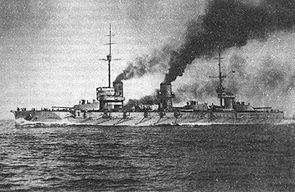 The hostilities on the Black Sea began unexpectedly for the Russian Empire. The Black Sea Fleet was taken by surprise and only the lack of sufficient firepower, the dispersal of forces, prevented German-Turkish the fleet become the master of the sea. The main reasons for this are the fear of the high command themselves to provoke a war with the Ottoman Empire and the lack of initiative of the command of the Black Sea Fleet.
The hostilities on the Black Sea began unexpectedly for the Russian Empire. The Black Sea Fleet was taken by surprise and only the lack of sufficient firepower, the dispersal of forces, prevented German-Turkish the fleet become the master of the sea. The main reasons for this are the fear of the high command themselves to provoke a war with the Ottoman Empire and the lack of initiative of the command of the Black Sea Fleet. But as shown storyfor Russia, the war often begins unexpectedly, but the Russians very quickly “enter” the process and intercept the strategic initiative from the enemy. The Black Sea Fleet did not take a “breather”, but immediately replied: November destroyers under the cover of battleships put mines (during the war years the Black Sea Fleet installed 4 thousands of mines) from the Bosporus, the battleship Rostislav, the cruiser Kagul and 7 destroyers fired at Zunguldak, destroying coal storages, 13 Turkish transport. On the way back, the squadron sank the Turkish minesweeper 6, more than 2 people were taken prisoner. 3-200 November Russian squadron goes to search for enemy ships, shelling Trebizund and meets on the way back with the German cruiser "Geben."
Fight at Cape Sarych (November 18, according to 5 st.)
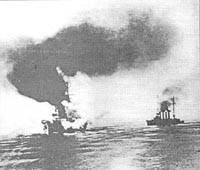 The remoteness of the main base of the Black Sea Fleet - Sevastopol, from the Bosphorus did not allow to establish a permanent blockade of the Turkish fleet. Russian squadron was forced to periodically return for repair and rest. Since the Goeben was superior to any Russian battleship in firepower and speed, the Russian command was to keep the main forces together. The fleet headquarters believed that the German cruiser could move with the speed of 29 knots, but in reality, because of the impossibility of quality repairs in Turkey, the speed of the Geben did not exceed the 24 knots. For example: the flagship of the Russian squadron "Evstafy" could go as fast as possible with the speed of 16 nodes, the cruiser "Cahul" - the 23 node. But the Russian squadron had one interesting novelty - before the war, the shooting of a ship connection for one target was worked out.
The remoteness of the main base of the Black Sea Fleet - Sevastopol, from the Bosphorus did not allow to establish a permanent blockade of the Turkish fleet. Russian squadron was forced to periodically return for repair and rest. Since the Goeben was superior to any Russian battleship in firepower and speed, the Russian command was to keep the main forces together. The fleet headquarters believed that the German cruiser could move with the speed of 29 knots, but in reality, because of the impossibility of quality repairs in Turkey, the speed of the Geben did not exceed the 24 knots. For example: the flagship of the Russian squadron "Evstafy" could go as fast as possible with the speed of 16 nodes, the cruiser "Cahul" - the 23 node. But the Russian squadron had one interesting novelty - before the war, the shooting of a ship connection for one target was worked out. On November 17, “Goben” and “Breslau” took to sea in order to intercept Russian ships and, with a favorable outcome, attack. On the same day, Admiral A. A. Ebergard received a report from the Naval General Staff about the Germans leaving the sea. But the lack of coal did not allow to start the search and heightened the vigilance of the squadron moved to the Crimea. The clash occurred 18-th in about 45 miles from Cape Chersonese, at Cape Sarych. In 11.40, the enemy ship was noticed by the cruiser “Almaz”, which was walking in the reconnaissance, and at the same time radio intercept was made. Russian ships reduced the intervals between themselves, the destroyers pulled up to the main forces. Then the Almaz and the Cahul cruisers, the Memory of Mercury, which went on reconnaissance, were recalled.
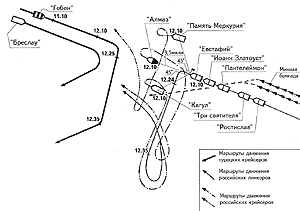 Due to heavy fog and smoke, which was leading the flagship ahead, the battle was reduced to a shootout of “Geben” and “Evstafiy” (captain of 1 rank V.I. Galanin). The senior artilleryman V.M. Smirnov, who directed the fire of the brigade of the battleships (he was on “John Chrysostom”), could not accurately determine the distance to the enemy ship, therefore the shells from the other battleships flew with the flight. The battle was just 14 minutes, Russian ships (with 34-40 cable, 6-7 km), fired 30 shells main caliber. Russian gunners "Evstafiya" from the first volley hit the target, 12-inch "hotel" breaking the German's 150-mm armor, caused a fire in the stern of the left side. It was a success, usually even good gunners (like the Germans) got from the 3 th volley. Goeben changed course and fired back. Soon, the Germans realized that the Russians had taken Tsushima’s bloody lesson into account, for 14 minutes of the battle, “Goeben” got 14 hits, including 3 and 305 mm shells. He took advantage of his superiority in speed and while the other Russian battleships were not shot, went into the fog.
Due to heavy fog and smoke, which was leading the flagship ahead, the battle was reduced to a shootout of “Geben” and “Evstafiy” (captain of 1 rank V.I. Galanin). The senior artilleryman V.M. Smirnov, who directed the fire of the brigade of the battleships (he was on “John Chrysostom”), could not accurately determine the distance to the enemy ship, therefore the shells from the other battleships flew with the flight. The battle was just 14 minutes, Russian ships (with 34-40 cable, 6-7 km), fired 30 shells main caliber. Russian gunners "Evstafiya" from the first volley hit the target, 12-inch "hotel" breaking the German's 150-mm armor, caused a fire in the stern of the left side. It was a success, usually even good gunners (like the Germans) got from the 3 th volley. Goeben changed course and fired back. Soon, the Germans realized that the Russians had taken Tsushima’s bloody lesson into account, for 14 minutes of the battle, “Goeben” got 14 hits, including 3 and 305 mm shells. He took advantage of his superiority in speed and while the other Russian battleships were not shot, went into the fog. The fight with the outdated Russian warrior was not cheap for the Germans - total losses from 112 to 172 people (according to various sources). But “Evstafy” suffered losses, from 19-ti 280 mm shells, which the German cruiser released four (4) hit the Russian battleship. Flagship lost 58 people (33 killed, 25 injured).
What conclusions can be made after this transient battle? First, a team of old battleships could well resist a new type of battleship (dreadnought). One battleship will be defeated, but in the compound they represent a formidable force if the crews are well prepared, which was confirmed by the 10 battle of May 1915. Secondly, the battle showed good training of Russian gunners, but the mediocre high command of the squadron - A. A. Ebergard could not organize a combined attack of his forces.
13 (26) December “Goeben” exploded 2 mines near the Bosphorus Strait, the area of the port side was 64 square. meter, and right - 50 square. meters, "sipped water" from 600 to 2000 tons. Specialists from Germany had to be called in for repair, the restoration work was basically completed by April 1915.
At the very end of 1914, the 5 of German submarines ("UB 7", "UB 8", "UB 13", "UB 14" and "UB 15") crossed the Black Sea from the Mediterranean, and this complicated the situation.
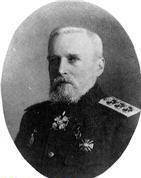 Help: Andrei Avgustovich Ebergard, commander of the Black Sea Fleet from 1911 to June 1916. 1878 completed the Naval Cadet Corps, from 1882 to 1894, serves in the Pacific, 1894-1896. marine agent in the Ottoman Empire. Then he serves on the Donets cannon (1896-1897), the battleship Catherine II, and Chesma in the Black Sea. 1898 was transferred to the Pacific Ocean again, the commander of the canoner “Manjur” (1899-1901), participates in suppressing the Ihetiuan uprising. From 1902, the rank of captain of the 1 rank, from January 1903, the flag captain of the headquarters of the Chief of the Pacific Squadron; from March 1904, the flag-captain of the Naval marching headquarters of the Emperor's Steward in the Far East EI Alekseev. 1905 was commanded by the battleship Alexander III, Panteleimon, from 1906 the assistant to the Chief of the Marine General Staff, 1907 was the Rear Admiral, 190-1911. Chief of the Marine General Staff, 1909, promoted to vice-admirals.
Help: Andrei Avgustovich Ebergard, commander of the Black Sea Fleet from 1911 to June 1916. 1878 completed the Naval Cadet Corps, from 1882 to 1894, serves in the Pacific, 1894-1896. marine agent in the Ottoman Empire. Then he serves on the Donets cannon (1896-1897), the battleship Catherine II, and Chesma in the Black Sea. 1898 was transferred to the Pacific Ocean again, the commander of the canoner “Manjur” (1899-1901), participates in suppressing the Ihetiuan uprising. From 1902, the rank of captain of the 1 rank, from January 1903, the flag captain of the headquarters of the Chief of the Pacific Squadron; from March 1904, the flag-captain of the Naval marching headquarters of the Emperor's Steward in the Far East EI Alekseev. 1905 was commanded by the battleship Alexander III, Panteleimon, from 1906 the assistant to the Chief of the Marine General Staff, 1907 was the Rear Admiral, 190-1911. Chief of the Marine General Staff, 1909, promoted to vice-admirals.1915 year
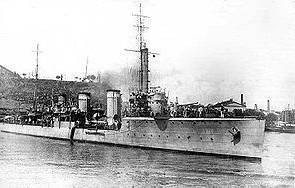 Consistently the Black Sea Fleet got rid of the shortcomings. For the reconnaissance of the Turkish ways, destroyers and hydroaviation began to be used; the effectiveness of agents was increased. But still the absence of a base in the southwestern part of the sea did not allow for the complete blockade of the Turkish forces.
Consistently the Black Sea Fleet got rid of the shortcomings. For the reconnaissance of the Turkish ways, destroyers and hydroaviation began to be used; the effectiveness of agents was increased. But still the absence of a base in the southwestern part of the sea did not allow for the complete blockade of the Turkish forces.From the beginning of January to the end of March 1915, the Russian squadron made 9 trips to enemy shores; artillery strikes were carried out across Zunguldak and Trapezund. 10s of steamboats, sailing ships with military cargoes were sunk. Russian submarines began to patrol the rn Bosphorus. The Batumi destroyer squadron was created - the 5 division ("Enviable", "Zavetny", "Voiced" and "Vigilant"). March 28 For the first time, the Black Sea squadron fired on and attacked with a bombing strike (hydraulic transport "Nikolay I" with 5 hydroplanes) on the fortifications of the Bosphorus. The ports in Kozlu, Eregli, Zunguldak districts were also shelled.
The plan of the Odessa operation and its failure
Admiral V. Sushon decided to take advantage of the fact that the Goeben was largely restored and inflict retaliation - in Odessa. Why chose Odessa? It was in Odessa that Russian troops could concentrate, to capture the Bosphorus, therefore, having destroyed transports, Souchon disrupted the plans of the Russian command and at the same time showed that the Turkish fleet was alive and capable.
The Ottoman Empire at that moment could have been defeated because of an attack from 3's directions: from February 18, the Anglo-French fleet attacked the Dardanelles, the Dardanelles operation began; the Russian fleet bombards the Bosphorus and prepares the landing army in Odessa, and the seizure of Constantinople-Istanbul by the Russians is a terrible dream of the Turks in recent decades. And at the end of 1914, the beginning of 1915, the Russian troops destroy the 3 of the Turkish army under Sarykamysh, the road to Anatolia is open. And here it is possible to eliminate the threat from one direction.
The plan of the operation was quite simple: the Goben and Breslau cover the strike forces from Sevastopol, the cruiser “Medgidiye” and the “Hamidiye” with 4 destroyers fired at Odessa at that time, destroying amphibious transports. The plan of the Turks was doomed to success. However, the case was spoiled by Russian minefields. The Russian Empire at that time was the world leader in the field of mine weapons. Turks and Germans clearly underestimated the mine danger. For which they paid.
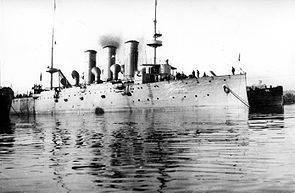 The commander of the operation was the German captain of the cruiser "Medgidiye" - Buksel. On April 1, the Turkish detachment left the Bosphorus, on the night of 3 was in the district of Odessa. The detachment strayed off the course a bit at night and went ashore about 15 miles east of the target point. Byuksel changed course and moved to the west, to Odessa. He planned to begin shelling from the north, then moving south and southeast to continue shelling. Ahead went destroyers with trawls, to search for mines. Behind them exactly in the wake of the cruiser. Suddenly, in “6.40” the “Megidiye” was blown up, the explosion occurred on the port side, the cruiser began to sink quickly with a roll on the port side. He did not drown completely, it was too small a depth. The Turks threw out the bolts of the guns, destroyed the walkie-talkie, the crew took off the destroyers. In 7.20, one of the destroyers torpedoed a cruiser, in order to completely submerge it. Turkish detachment retreated.
The commander of the operation was the German captain of the cruiser "Medgidiye" - Buksel. On April 1, the Turkish detachment left the Bosphorus, on the night of 3 was in the district of Odessa. The detachment strayed off the course a bit at night and went ashore about 15 miles east of the target point. Byuksel changed course and moved to the west, to Odessa. He planned to begin shelling from the north, then moving south and southeast to continue shelling. Ahead went destroyers with trawls, to search for mines. Behind them exactly in the wake of the cruiser. Suddenly, in “6.40” the “Megidiye” was blown up, the explosion occurred on the port side, the cruiser began to sink quickly with a roll on the port side. He did not drown completely, it was too small a depth. The Turks threw out the bolts of the guns, destroyed the walkie-talkie, the crew took off the destroyers. In 7.20, one of the destroyers torpedoed a cruiser, in order to completely submerge it. Turkish detachment retreated.The Russian fleet withdrew from Sevastopol and attacked the German cruisers, they did not accept the battle and fled. What is interesting the enemy was discovered for the first time with the help of seaplanes.
8 of June 1915 of the year “Medgidiye” was lifted, initial repair was carried out in Odessa, then capital repair in Nikolaev, was reequipped and a year later in June 1916 entered the Black Sea Fleet as “Prut”. As part of the fleet, he participated in several operations, in May 1918 was captured by the Germans, transferred to the Turks, and there, thanks to Russian repairs, he served in the service of the Turkish fleet right up to the 1947 year.
Plan for the Bosphorus Operation
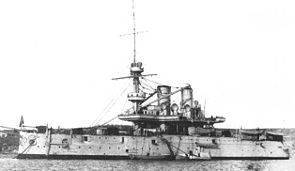 After the Crimean War (1853-1856), the Russian Empire planned various options for waging war with the Ottoman Empire. After the Russian-Turkish war 1877-1877 it became finally clear that only ground forces can be defeated only at the cost of large losses, resource and time losses. Too long distance from the Danube and the Caucasus to Istanbul, besides protected by strong fortresses.
After the Crimean War (1853-1856), the Russian Empire planned various options for waging war with the Ottoman Empire. After the Russian-Turkish war 1877-1877 it became finally clear that only ground forces can be defeated only at the cost of large losses, resource and time losses. Too long distance from the Danube and the Caucasus to Istanbul, besides protected by strong fortresses.Therefore, with the revival of the Black Sea Fleet, the idea of a Bosporus operation arose. With its help, it was possible to decapitate the old enemy with one blow and realize the age-old Russian dream - to return to the bosom of the Orthodox world, the ancient Tsargrad-Constantinople. To implement this plan, a powerful armored fleet was needed, an order of magnitude stronger than the Turkish naval forces. The fleet was built from 1883 year laid battleships of the "Empress Catherine the Great" type, a total of 4 ships were built ("Chesma", "Sinop", "George the Victorious"), and two of them participated in the First World War - "Sinop" and "George Victorious. In addition, the navy and the Volunteer Fleet (for the transport of troops) were intensively developed. In the event of war, these battleships would be enough to liquidate the Turkish fleet. They were built to perform two tasks: 1) squadron combat; and 2) the destruction of coastal fortifications, the suppression of enemy batteries.
But the defeat in the Russo-Japanese War pushed these plans aside. The task of reviving the fleet came to the fore. But right up until the emergence of Turkey "Geben" with "Breslau", theoretically, the Black Sea Fleet could perform this operation, there was enough strength.
After the Allies launched the Dardanelles operation, the Russian fleet systematically conducted demonstrative actions against the Bosporus. If the British succeeded in the Dardanelles, the Black Sea Fleet would have to occupy the Bosphorus. Russian troops were forced to Odessa, a demonstrative load on the transports was carried out. Vigorous activity created the appearance of preparing a large-scale landing operation. Although before the commissioning of new battleships, she would hardly have brought success. Yes, and the German offensive 1915, did not allow to allocate large forces for the operation.
A real opportunity appeared only in 1916: the Caucasian Front conducted a successful Erzerum operation, the South-Western Front successfully crushed Austro-Hungarians, the German troops tried to defeat the Anglo-French armies or the West. The Russian command had reserves for the operation. The newest battleship 2 was put into operation, this “Goeben” was neutralized. The operation was planned to begin in 1917, but the February revolution threw the empire into the abyss of anarchy and the Civil War. The dream of the Russian Slavophiles never became a geopolitical reality - Tsargrad did not become the third capital of the Russian Empire.
From 28 March to 10 in May, the Russian fleet 4 times shelled the Bosphorus. In this case, the 2 battleship was fired at coastal fortifications, 3 was covered from the sea. On May 10, the Goben attacked the ships in cover (Evstafy, John Chrysostom, and Rostislav). None of the parties succeeded when the Russian battleship Panteleimon entered the battle and made three hits with 4-mm projectiles right away, the Goeben was not badly damaged, but realizing that superiority was on the side of the enemy, he left. The shootout itself went on just 305 minutes.
September 3 on the side of Germany was Bulgaria. In September, the 1915 of the year, when the 2 new battleship of the Dreadnought type entered the Black Sea Fleet, the 3 brigade of ships was created, each superior in power to the Geben. 1-i in the composition: dreadnought "Empress Maria" and the cruiser "Cahul". 2-I in the composition: dreadnought "Empress Catherine the Great" and the cruiser "Memory of Mercury." 3-I in the composition: the battleships "Evstafy", "John Chrysostom" and "Panteleimon". The linear ships "Three Saints" and "Rostislav" were combat-ready reserve. Organizationally, the dreadnoughts "Empress Maria", "Empress Catherine the Great" and cruisers of the type "Cahul" were consolidated into the 1 brigade of the fleet, and the battleship "Eustachy", "John Chrysostom" and "Panteleimon" - into the 2 brigade of the brigade fleet.
In general, since that time, the Russian fleet has received complete superiority, it is constantly firing on the enemy coast. With the advent of new submarines in the fleet, including a minelayer such as the "Crab", it became possible to cross the enemy's communications with the help of them. At the beginning of the submarine used the positional method - took up the position and were on duty, waiting for the enemy ship. Since the summer of the 1915 of the year, the cruising method was used when the boat patrolled in a certain area, alternately replacing each other.
The novelty of the Russian fleet was the interaction of submarines and destroyers of the destroyers. This method proved itself, increased the effectiveness of the blockade of the Bosphorus and coal districts of Turkey. Aerial reconnaissance was also developing rapidly; Russian sea pilots were among the world leaders in this field.
Information